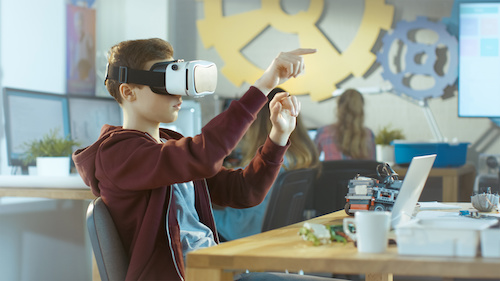Whether we like it or not, the fourth industrial revolution is fundamentally changing the way the world works–and educators have to rise to the task of preparing students for 2030 and beyond.
“We don’t have as much time as I thought we did to redesign education and prepare our students for the future,” said Dr. David Gundlach, the deputy superintendent of Wisconsin’s Oshkosh Area School District (OASD), during CoSN 2019. “It’s very common for districts to create based on their past instead of students’ future.”
While many people believe the world still in the third industrial revolution, which consisted of digital evolutions and modernizations, the fourth industrial revolution has already started: robotization, nanotech, and artificial intelligence (AI), Gundlach said.
Read more: How to prepare students for the unknowable
And when it comes to preparing students for 2030, AI and its quickly-evolving state should be topmost in educators’ minds.
“The interesting thing about this is that the speed of these breakthroughs has no historical precedent. This is going to disrupt all sectors at one time at an increasingly rapid pace. AI is everywhere. China is redesigning its entire education system, aiming kids toward careers in AI,” Gundlach said.
By 2020, the top 10 skills needed for academic and professional success will have changed, with complex problem-solving, critical thinking, and creativity taking top spots. And a new skill will appear on must-have lists, as predicted by the World Economic Forum’s Future Jobs Report: cognitive flexibility.
Cognitive flexibility will require people to forget the old way of doing things and learn new–and evolving–approaches.
“We need students and adults who can learn, unlearn, and relearn at an increasing pace. That cognitive flexibility has been taken out of curriculum, and we’re trying to put it back in,” Gundlach said. “Are we preparing our students for a career that will exist in 2030, or not?”
Schools’ role in preparing students for 2030–and beyond
Schools can take steps to help teachers and students get ready for the future of learning and work–in fact, teacher confidence will play a large role in how students are equipped to learn the skills they’ll need.
“Our challenge is moving from a 2-dimensional education of English and math to a multi-dimensional education that incorporates everything,” Gundlach said, noting that preparing students for the future isn’t about what technology tools they’re using, but is instead about the learning activities and skills students build.
OASD’s Learning Without Limits initiative is one way the district is preparing students for 2030. Programs in coding and robotics introduce students to important concepts that will play a pivotal role in future jobs.
After upgrading infrastructure, focusing on professional development and distributing one-to-one devices to teachers and students, the district is now focusing on integration and digital equity.
Read more: Teaching faculty to think like innovators
The district started participating in the Hour of Code, and from there, purchased programmable robots and converted old computer labs, which were no longer needed after implementing its one-to-one initiative.
“The first year, a lot of teachers wanted us to come in and teach kids about robotics, so we wound up doing robotics for the sake of robotics,” said Matthew Callahan, a technology integration coach in the district. “The next year, we needed more staff buy-in and wanted them to be comfortable integrating robotics into what they were already doing.”
District technology integration coaches and teachers collaborated to identify different opportunities to integrate robotics and coding. One such activity asks students to roll dice and move programmable mice in certain directions, depending on the sum of the numbers on the dice. Another activity consists of a “neighborhood” made out of blocks, and students program their robots to visit the library or grocery store. A coding night also helped involve parents and the community, and students had the opportunity to teach their parents and families about coding.
“The Hour of Code is a great way to get a foot in the door for teachers who are uncomfortable with coding,” said Kathleen Stephany, a district tech integration coach. “We’ve had all our K-5 students do it.” The Hour of Code also lets teachers take a different look at students’ interests and skills–for instance, one teacher had a student who performed poorly in math and reading, but who successfully progressed through a coding course much quicker than his peers, she added.
OASD also focuses on empowering girls to pursue STEM and coding by leveraging groups and resources such as Girls Who Code and Microsoft’s DigiGirlz, along with having women in STEM fields come work with students to explore different careers. “We have to keep their interest at that middle school level–66 percent of girls are interested in coding up to age 12, and then it drops to 22 percent in secondary,” Stephany said.
District leaders noticed that despite widespread enthusiasm for coding and robotics at the elementary level, the programs weren’t as successful in middle school, and the district decided to use the middle school curriculum as a bridge from elementary school to high school.
OASD replaced the traditional Family and Consumer Sciences course with a Digital Life Skills course in sixth grade. The course focuses on the skills students will need to build in high school in order to be successful after graduation: digital citizenship, advanced software usage, coding and robotics, soft skills, and digital photography and digital editing.
- Report details uneven AI use among teachers, principals - March 28, 2025
- Fighting chronic absenteeism with data-driven insights–and a little fun, too - March 26, 2025
- CoSN 2025: Humans in an AI world - March 21, 2025

